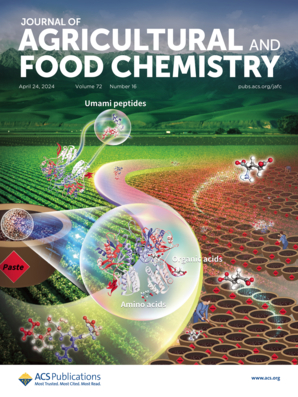n -乙酰乳胺一锅两步多酶法高效经济合成6′/3′-唾液基乳胺
IF 5.7
1区 农林科学
Q1 AGRICULTURE, MULTIDISCIPLINARY
引用次数: 0
摘要
在200多种母乳低聚糖中,6 ' -SLN(6 ' -唾液- n -乙酰乳胺)和3 ' -SLN具有潜在的抗病毒功能,可能促进大脑发育和知识。到目前为止,还没有开发出高效、经济的6′-SLN和3′-SLN的合成途径。本研究建立了以商业n -乙酰乳胺(LacNAc)为原料经济再生胞苷5 ' -三磷酸(CTP)的高效酶法合成6 ' -SLN和3 ' -SLN的途径,产率达95%。为满足工业化生产的要求,以原位生产的LacNAc为基础,进一步优化了它们的合成。因此,可以节省LacNAc净化的成本。此外,在pH 7.0和添加3批polyP6的条件下进行合成,6 ' -SLN的收率分别为95.0%和94.8%。在优化条件下,酶促合成6′-SLN和3′-SLN的产率分别为96.1% (259.2 g)和92.3% (248.7 g),产率为5 L。本研究将为今后3′-SLN和6′-SLN的工业化生产奠定基础,并为其他唾液化低聚糖的多酶法制备提供指导。本文章由计算机程序翻译,如有差异,请以英文原文为准。

Highly Efficient and Economical One-Pot Two-Step Multienzymatic Synthesis of 6′/3′-Sialyllactosamine from In Situ-Produced N-Acetyllactosamine
Among over 200 human milk oligosaccharides, 6′-SLN (6′-sialyl-N-acetyllactosamine) and 3′-SLN possess potential antiviral function and can potentially enhance brain development and knowledge. So far, no efficient and cost-effective synthetic pathways for 6′-SLN and 3′-SLN have been developed. In this study, efficient enzymatic pathways to synthesize 6′-SLN and 3′-SLN were established involving economic cytidine 5′-triphosphate (CTP) regeneration from commercial N-acetyllactosamine (LacNAc) with yields of >95%. To meet the requirement of industrial production, their synthesis was further optimized starting from in situ-produced LacNAc. Consequently, the cost of LacNAc purification could be saved. Furthermore, conducting synthesis at pH 7.0 and with supplementation of polyP6 in three batches led to yields of 6′-SLN (95.0%) and 3′-SLN (94.8%), respectively. Under optimized conditions, enzymatic syntheses of 6′-SLN and 3′-SLN were conducted at a 5 L scale with yields of 96.1% (259.2 g) and 92.3% (248.7 g), respectively. This study would lay the foundation for industrial production of 3′-SLN and 6′-SLN in the future and provide a guide for multienzymatic preparation of other sialylated oligosaccharides.
求助全文
通过发布文献求助,成功后即可免费获取论文全文。
去求助
来源期刊
CiteScore
9.90
自引率
8.20%
发文量
1375
审稿时长
2.3 months
期刊介绍:
The Journal of Agricultural and Food Chemistry publishes high-quality, cutting edge original research representing complete studies and research advances dealing with the chemistry and biochemistry of agriculture and food. The Journal also encourages papers with chemistry and/or biochemistry as a major component combined with biological/sensory/nutritional/toxicological evaluation related to agriculture and/or food.

 求助内容:
求助内容: 应助结果提醒方式:
应助结果提醒方式:


